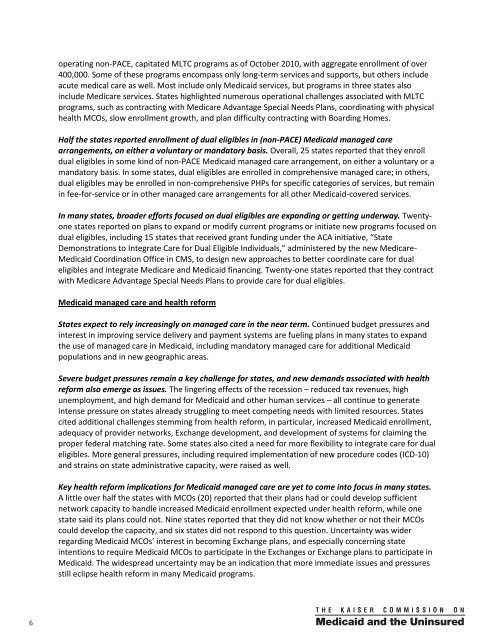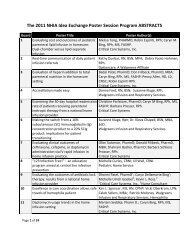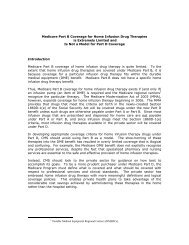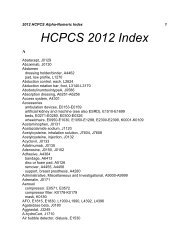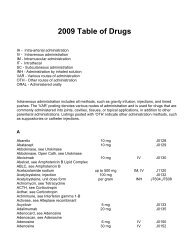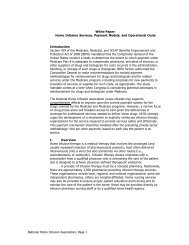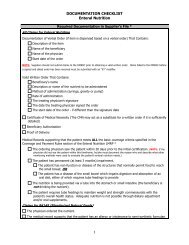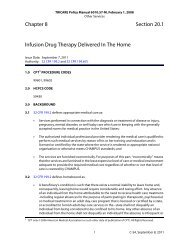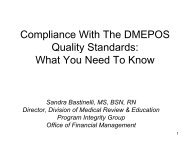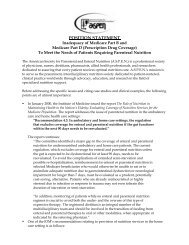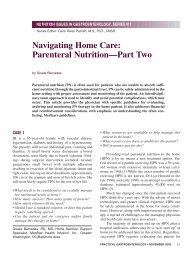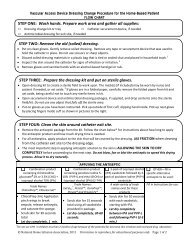Kaiser Family Foundation Survey on State Medicaid Managed Care ...
Kaiser Family Foundation Survey on State Medicaid Managed Care ...
Kaiser Family Foundation Survey on State Medicaid Managed Care ...
- No tags were found...
Create successful ePaper yourself
Turn your PDF publications into a flip-book with our unique Google optimized e-Paper software.
operating n<strong>on</strong>-PACE, capitated MLTC programs as of October 2010, with aggregate enrollment of over400,000. Some of these programs encompass <strong>on</strong>ly l<strong>on</strong>g-term services and supports, but others includeacute medical care as well. Most include <strong>on</strong>ly <strong>Medicaid</strong> services, but programs in three states alsoinclude Medicare services. <strong>State</strong>s highlighted numerous operati<strong>on</strong>al challenges associated with MLTCprograms, such as c<strong>on</strong>tracting with Medicare Advantage Special Needs Plans, coordinating with physicalhealth MCOs, slow enrollment growth, and plan difficulty c<strong>on</strong>tracting with Boarding Homes.Half the states reported enrollment of dual eligibles in (n<strong>on</strong>-PACE) <strong>Medicaid</strong> managed carearrangements, <strong>on</strong> either a voluntary or mandatory basis. Overall, 25 states reported that they enrolldual eligibles in some kind of n<strong>on</strong>-PACE <strong>Medicaid</strong> managed care arrangement, <strong>on</strong> either a voluntary or amandatory basis. In some states, dual eligibles are enrolled in comprehensive managed care; in others,dual eligibles may be enrolled in n<strong>on</strong>-comprehensive PHPs for specific categories of services, but remainin fee-for-service or in other managed care arrangements for all other <strong>Medicaid</strong>-covered services.In many states, broader efforts focused <strong>on</strong> dual eligibles are expanding or getting underway. Twenty<strong>on</strong>estates reported <strong>on</strong> plans to expand or modify current programs or initiate new programs focused <strong>on</strong>dual eligibles, including 15 states that received grant funding under the ACA initiative, “<strong>State</strong>Dem<strong>on</strong>strati<strong>on</strong>s to Integrate <strong>Care</strong> for Dual Eligible Individuals,” administered by the new Medicare-<strong>Medicaid</strong> Coordinati<strong>on</strong> Office in CMS, to design new approaches to better coordinate care for dualeligibles and integrate Medicare and <strong>Medicaid</strong> financing. Twenty-<strong>on</strong>e states reported that they c<strong>on</strong>tractwith Medicare Advantage Special Needs Plans to provide care for dual eligibles.<strong>Medicaid</strong> managed care and health reform<strong>State</strong>s expect to rely increasingly <strong>on</strong> managed care in the near term. C<strong>on</strong>tinued budget pressures andinterest in improving service delivery and payment systems are fueling plans in many states to expandthe use of managed care in <strong>Medicaid</strong>, including mandatory managed care for additi<strong>on</strong>al <strong>Medicaid</strong>populati<strong>on</strong>s and in new geographic areas.Severe budget pressures remain a key challenge for states, and new demands associated with healthreform also emerge as issues. The lingering effects of the recessi<strong>on</strong> – reduced tax revenues, highunemployment, and high demand for <strong>Medicaid</strong> and other human services – all c<strong>on</strong>tinue to generateintense pressure <strong>on</strong> states already struggling to meet competing needs with limited resources. <strong>State</strong>scited additi<strong>on</strong>al challenges stemming from health reform, in particular, increased <strong>Medicaid</strong> enrollment,adequacy of provider networks, Exchange development, and development of systems for claiming theproper federal matching rate. Some states also cited a need for more flexibility to integrate care for dualeligibles. More general pressures, including required implementati<strong>on</strong> of new procedure codes (ICD-10)and strains <strong>on</strong> state administrative capacity, were raised as well.Key health reform implicati<strong>on</strong>s for <strong>Medicaid</strong> managed care are yet to come into focus in many states.A little over half the states with MCOs (20) reported that their plans had or could develop sufficientnetwork capacity to handle increased <strong>Medicaid</strong> enrollment expected under health reform, while <strong>on</strong>estate said its plans could not. Nine states reported that they did not know whether or not their MCOscould develop the capacity, and six states did not resp<strong>on</strong>d to this questi<strong>on</strong>. Uncertainty was widerregarding <strong>Medicaid</strong> MCOs’ interest in becoming Exchange plans, and especially c<strong>on</strong>cerning stateintenti<strong>on</strong>s to require <strong>Medicaid</strong> MCOs to participate in the Exchanges or Exchange plans to participate in<strong>Medicaid</strong>. The widespread uncertainty may be an indicati<strong>on</strong> that more immediate issues and pressuresstill eclipse health reform in many <strong>Medicaid</strong> programs.6 00


